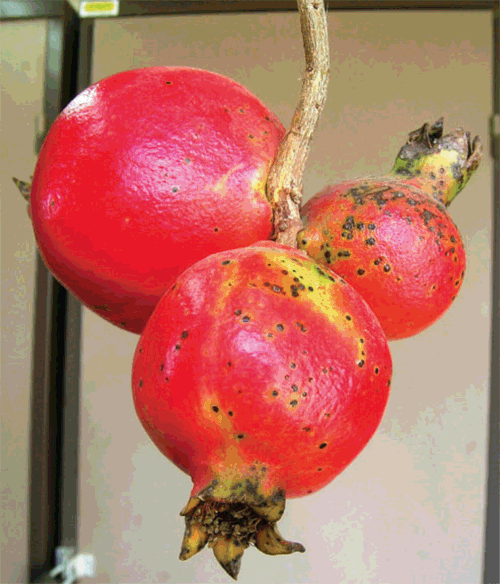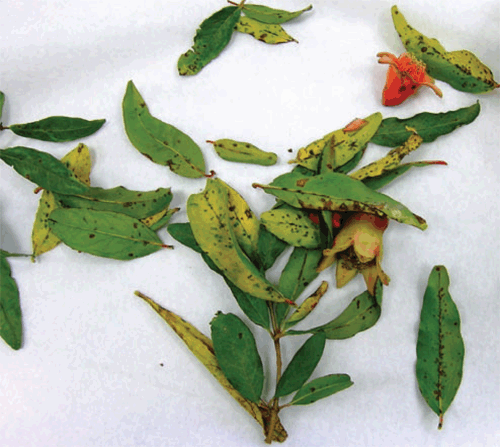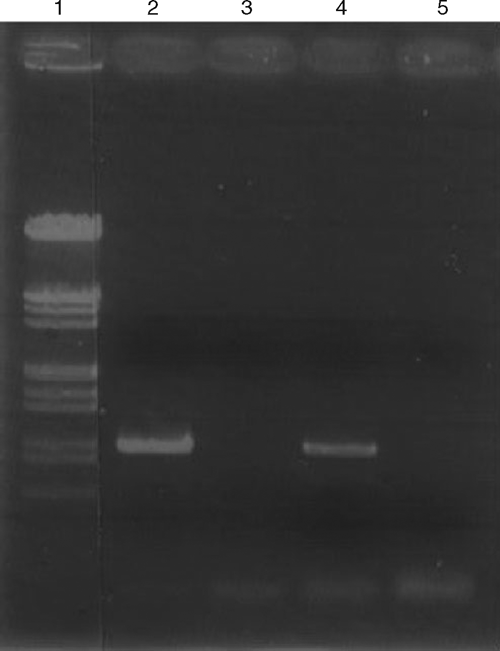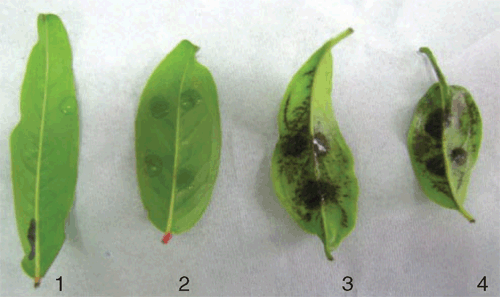First report of Alternaria black spot of pomegranate caused by Alternaria alternata in Israel
D. Ezra A C , T. Gat A , Y. Skovorodnikova A , Y. Vardi B and I. Kosto BA Department of Plant Pathology and Weed Research, ARO, The Volcani Center, Israel.
B Ministry of Agriculture and Rural Development Extension Service, PO Box 6, Bet-Dagan 50250, Israel.
C Corresponding author. Email: dezra@volcani.agri.gov.il
Australasian Plant Disease Notes 5(1) 1-2 https://doi.org/10.1071/DN10001
Submitted: 24 November 2009 Accepted: 3 December 2009 Published: 18 January 2010
Abstract
Black spot disease of pomegranate is a new disease caused by Alternaria alternata on pomegranates in Israel. Symptoms can be seen on the leaves and fruits but no damage to the inner edible tissue is found. The causal agent was isolated and Koch Postulates were demonstrated. This is the first report of black spot disease of pomegranate in Israel.
In 2004 a new disease was observed in pomegranate (Punica granatum) orchards in Israel. Black spot symptoms were noted on leaves and fruits, ranging from a single spot to more than 50% of the fruit surface (Fig. 1); some leaves became chlorotic and abscised (Fig. 2). Spots, which appeared at the start of the summer on all cultivars, were small (1–3 mm) and round on fruit and round to irregular (1–4 mm) on leaves. Each spot consisted of a green-yellow halo surrounding a necrotic lesion. Damage to fruit was limited to the peel surface; the edible tissue was not damaged.

|

|
Symptomatic fruits and leaves were collected during the summer of 2007. Lesion pieces were plated on potato dextrose agar (PDA) amended with 12 µg/L tetracycline and incubated at 25°C. Fungal colonies emerging from symptomatic tissue had morphology and conidia typical of Alternaria spp. Sequence analysis of the rDNA ITS region and β-tubulin gene of four different pathogenic isolates (A17, D2, 49, 53) from different cultivars were found to be identical (i.e. A17 GenBank accessions GQ240306, GQ240308), exhibiting 100% identity to A. alternata (accessions FJ946480; EU139350). Polymerase chain reaction (PCR specific primers, apPCR-based) revealed differences between A. alternata isolated from pomegranates affected by ‘black rot’ and A. alternata isolated from ‘black spot’ disease (Fig. 3). Other Alternaria isolates from non-symptomatic pomegranate and other fruits, pathogenic and non-pathogenic, were not identified by the designed primers (data not shown).

|
Laboratory pathogenicity was assessed by detached leaf and fruit inoculation. Drops (10 µL) of a 106 conidia/mL suspension, from 50 different isolates, were inoculated on leaves (~2 weeks old), fruit (~2 months old) and flowers, placed in a moist chamber (25°C). Symptoms appeared 48–72 h later and were similar to those observed in the field. Koch’s Postulates were completed by inoculation of greenhouse plants (25°C, 14 h photoperiod). Plants (3–6 months old), cvv. Wonderful and Shami, were sprayed or drop-inoculated with a 106 conidia/mL suspension and covered with plastic bags for 1 month. Black spots appeared on leaves approximately 1 week after inoculation; the fungus was reisolated from infected leaves. Alternaria alternata from ‘black rot’ did not cause symptoms when inoculated on leaves (Fig. 4). This is the first report of A. alternata causing black spot disease of pomegranate in Israel. We believe that this is the first record of Alternaria black spot on pomegranate fruit while leaf spot has been previously reported in India (Madhukar and Reddy 1988).

|



